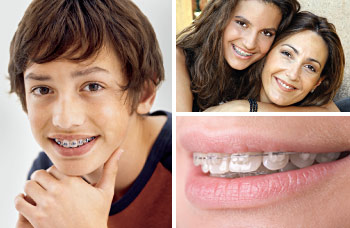The Magic of Orthodontics
The Original Smile Makeover

The first article in this series on “Smile Design” provided an overview of the many facets involved in creating “smiles by design” and the many ways of interpreting what is both normal and ideal. When you communicate your desire for an improved or enhanced smile to your dentist, he or she will discuss their role as your diagnostician, artist, and scientist. You and your dentist will work together to develop the best course of action for your individual and particular situation. The second article in the series discussed porcelain laminate veneers as a way of enhancing your aesthetics when the situation is right for them to work their magic.
The third article in this series discusses the role of orthodontics, moving the teeth into better position. Orthodontics is a sub-specialty of dentistry that is devoted to the study and treatment of malocclusions (improper bites). Improper bites may result from tooth irregularity or positioning, disproportionate jaw relationships, or both. The word orthodontics is derived from the Greek language (ortho) meaning straight and (odont) meaning tooth. Today, orthodontics means tooth movement and possibly much more...
Orthodontic treatment may focus on improving poor positioning of teeth and bite relations or, may even influence the way the face shapes and forms over time. Orthodontic treatment can be carried out for purely cosmetic reasons, improving the general appearance of a person's teeth and face. In addition, treatment may be necessary to functionally improve the bite (occlusion). Often both goals can be accomplished simultaneously.
One of the most important and fundamental considerations in smile design is the position of the teeth themselves; how do they actually fit into the framework of the face and jaws and how do the upper and lower jaws relate to each other. By analogy, before renovating or building a house it is important to consider whether the foundation is not only sound, but in the right position.
Orthodontics — A Unique Contribution to Smile Design
A pre-requisite to smile design is the proper positioning and alignment of the teeth. Only orthodontic treatment can move teeth into better position. Consider the following two outcomes of this unique contribution:
- Create a new smile — by orthodontic treatment alone.
- Improve the position and biting function of the teeth; to achieve a more complete aesthetic transformation — by a “team” approach in which other dental specialties work their magic.

Rules of the Game — Where to Start
Take the time to have a proper evaluation of your dental situation and learn what options are available and best for you. A good place to start is with your general dentist. Most dentists who practice “Smile Design/Cosmetic Dentistry” also tend to work in teams.
Try to use the right treatment approach the first time so as not to cut corners. This may well involve developing a trusting relationship with your dentist who knows who to contact. The combined knowledge, skill and judgment of an experienced dental professional team will allow the development of a personalized plan — what the right options are for you to create a long lasting new or enhanced smile. This approach may take some time, but don't be in a hurry — smile design for life takes time. As the saying goes “Rome wasn't built in a day.”
What is an Orthodontist?
An orthodontist is a dentist who has taken advanced specialty training in several areas. Some general dentists also practice orthodontic treatment, having taken varying degrees of advanced training in this specialty area. The most important part is understanding that form and function go hand in hand. The position of teeth dictates how your teeth work together and affects the way you look and smile. Simply put, when things look right, they probably are right. Orthodontics requires an understanding of the “mechanics” of how to move teeth in to the right position through three operating principles:
- Development: The growth and development of the teeth and jaws.
- Alignment: The alignment of teeth within the dental arches or jaws.
- Occlusion: The bite or how teeth come together and function in harmony with the jaw joints.
Orthodontic Diagnosis
Being trained in growth and development, an orthodontist will determine the ideal age to evaluate and treat a young growing patient. Growth can play an important role in the design of the treatment plan and orthodontic mechanics (tooth movement) itself. Growth can actually be assessed and sometimes modified through orthodontic treatment and can be an important ally to an aesthetic, functional and stable result. Since growth is complete in adults, a different approach to treatment is needed.
Before a problem can be fixed, there must be a clear understanding of how and why the teeth came to be in their present position. As with most things, this takes careful assessment or “diagnosis.” Dental and medical histories are necessary to ascertain whether you are healthy enough to undergo orthodontic treatment. Detailed records will also be needed including:
- Impressions to make molds of your teeth and the way they meet, are known simply as study models.
- Articulated models — these study models can be placed in a machine called an articulator which replicates jaw movement for study purposes.
- Specialized radiographs (x-rays) of the teeth and the relationship of the jaws.
- Photographs of your smile and position of the teeth.
- Computer imaging.
All the above records are necessary in order to “image and imagine” what is possible related to your particular bite. These records help your orthodontist to determine the best plan of action to provide not only the best esthetics, but also functional improvement, ultimately to protect your dental health for a lifetime.
Records are also necessary to understand how to stabilize the teeth to prevent the possibility of the teeth moving back or relapsing after movement with orthodontic treatment.

